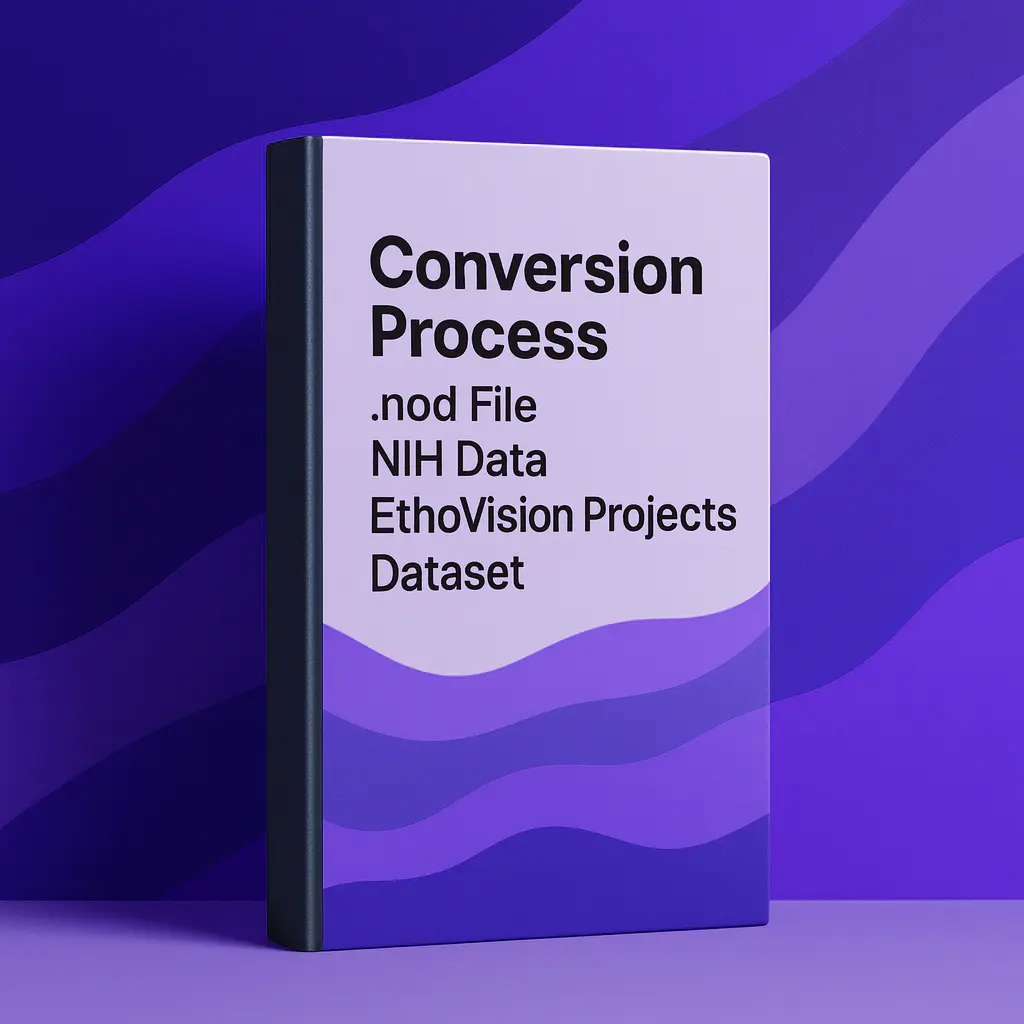

But what happens when your data lives in a .nod file, the proprietary format used by EthoVision XT?
Here’s your go-to guide for understanding .nod files, the roadblocks they pose for data sharing, and how ConductVision streamlines the conversion process, from raw trial data to fully NIH-compliant exports.
If you’re working with EthoVision XT, you’ve likely come across a file with the .nod extension — and maybe wondered what exactly lives inside it.
The .nod file is EthoVision’s project container, acting like the brain of your experiment. It doesn’t store your raw video footage or final results. Instead, it functions as a master blueprint that ties everything together from experimental setup to analysis configuration.
Here’s what’s typically embedded in a .nod file:
In short, the .nod file is a critical but closed-off resource. It holds the entire experimental logic and links to data but unless you have access to EthoVision XT, it’s essentially a black box.
That’s why .nod files are so problematic for collaboration, review, and data sharing. Without EthoVision, you can’t access the structure, configuration, or behavior definitions, let alone convert the data to formats suitable for NIH compliance or long-term archiving.
While EthoVision’s .nod files work well within the software environment, they’re notoriously difficult to use outside of it, especially when it comes to collaboration, publication, or NIH data sharing requirements.
Here’s why researchers often hit a wall when trying to archive or share .nod-based datasets:
The .nod format is proprietary and closed, there’s no public specification, and no third-party software can open or interpret them. If you don’t have access to a licensed copy of EthoVision XT, you’re out of luck. Reviewers, collaborators, or repository managers can’t view your experimental setup, zone definitions, or behavioral events without it.
Unlike other project containers that store all assets internally, .nod files only reference video files, they don’t actually contain them. That means if the videos are moved, renamed, or missing, the .nod file becomes useless. Re-linking paths is not only tedious, it’s a barrier for data portability.
Most .nod exports lack key metadata required for NIH compliance:
Unless researchers manually enter this metadata elsewhere, the dataset fails to meet NIH Common Data Elements (CDE) standards making it incomplete for repository submission or reuse.
There’s no “Export to JSON” or “Save as CSV with metadata” button in EthoVision. You have to:
There’s no viewer for .nod files outside EthoVision. To work with them, you need:
It’s possible, but time-consuming, tedious, and error-prone.
The NIH expects:
And none of that is embedded in a .nod file by default.
For researchers juggling NIH compliance and tight deadlines, manually converting .nod files isn’t just frustrating, it’s risky. That’s where ConductVision changes the game.
ConductVision was purpose-built to bridge the gap between proprietary behavioral research tools like EthoVision XT and the open data standards required by NIH repositories. It’s not a workaround, it’s a full upgrade to your data workflow.
With ConductVision, you no longer need to worry about how to:
ConductVision automates all of it. Once you import your .nod project, the platform reconstructs your experimental setup, maps variables to official ontologies, and exports your dataset in NIH-compliant formats all while preserving scientific integrity and reproducibility.
What Happens Under the Hood
When you upload your .nod file (along with your tracking CSVs and raw videos), ConductVision does the heavy lifting:
At the end of the process, ConductVision generates a repository-ready folder structure that includes
Everything is UTF-8 encoded, FAIR-compliant, and ready to upload to platforms like OSF, OpenNeuro, or SPARC.
For NIH-funded labs using EthoVision, compliance isn’t optional, and manual conversion is a bottleneck. ConductVision replaces that bottleneck with speed, structure, and scientific rigor.
No more wrestling with locked files, scattered metadata, or formatting headaches. Just import your project, and let ConductVision handle the rest.
Manual conversion requires you to juggle EthoVision exports, re-enter metadata, convert formats, and build your own folder structure. It’s doable, but slow.
With ConductVision, you import once and everything else is handled for you. This is the difference between hours of work and a few clicks.
If you’re managing dozens (or hundreds) of EthoVision experiments, this isn’t just convenience, it’s sustainability.
Working with .nod files may be part of your everyday workflow but when it comes time to share, publish, or archive that data, the clock starts ticking.
The NIH’s Data Management and Sharing (DMS) Policy isn’t just a formality, it’s a clear directive for transparency, openness, and reproducibility. That means your data can’t live inside a locked file format, even if that format has served you well during analysis.
Whether you’re a PI managing multiple studies, a postdoc preparing a grant renewal, or a lab manager coordinating submissions, the message is clear:
If your research relies on .nod files, you need a strategy to convert and share that data — now, not later.
Too often, labs wait until just before a funding deadline or data deposition requirement to scramble for tools, export files manually, and reconstruct missing metadata from old notebooks. That’s not just inefficient, it’s risky. Critical information gets lost, datasets become noncompliant, and the credibility of your research may suffer.
ConductVision offers an immediate, reliable solution:
It automates every step from .nod import to NIH-ready export, helping your team stay focused on discovery, not documentation.
Book a complimentary migration consultation to see how ConductVision can convert your existing .nod archives into clean, compliant, sharable datasets.
